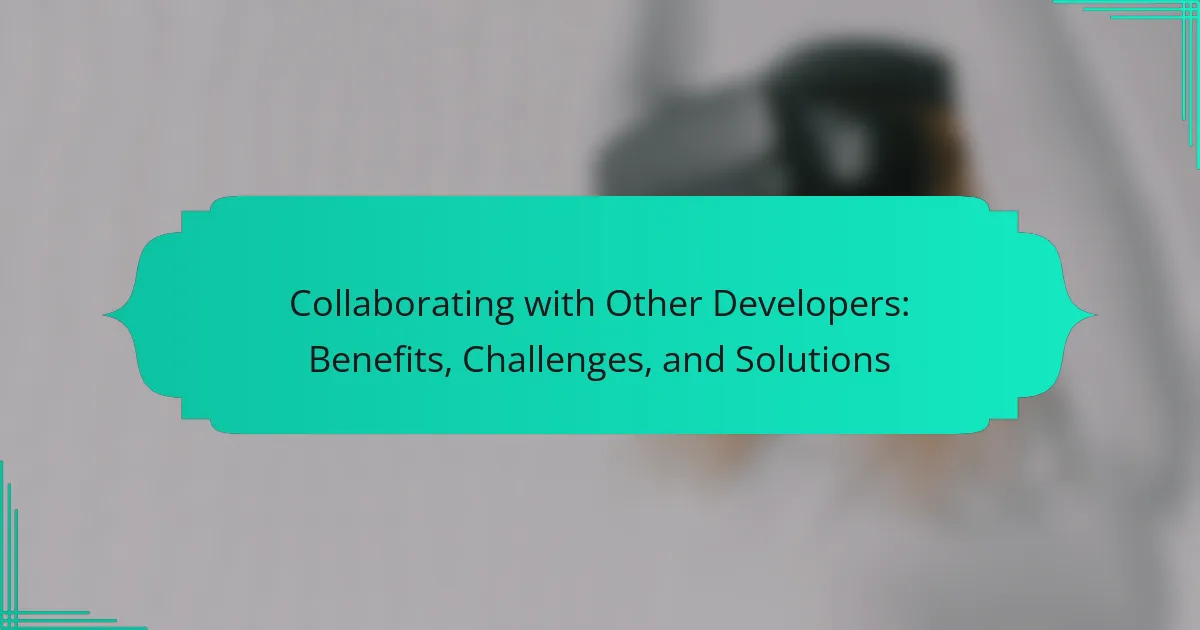Collaborating with other developers enhances creativity and improves code quality but also presents challenges like communication barriers and differing coding styles. This article explores the benefits of collaboration, identifies common challenges, and offers effective solutions to foster teamwork. It discusses the importance of clear communication, collaborative tools, and understanding cultural differences to improve project outcomes.

What are the key benefits of collaborating with other developers?
Collaborating with other developers enhances creativity, accelerates problem-solving, and fosters knowledge sharing. It leads to improved code quality through peer reviews and diverse perspectives. Additionally, collaboration can reduce workload and increase project efficiency by leveraging each member’s strengths.
How does collaboration enhance project outcomes?
Collaboration enhances project outcomes by fostering innovation, improving problem-solving, and increasing efficiency. When developers work together, they share diverse perspectives and skills, leading to higher-quality solutions. This collective effort can address challenges more effectively, as team members leverage each other’s strengths. Moreover, collaboration often results in better communication, reducing misunderstandings and streamlining processes. Ultimately, collaborative environments can boost morale and motivation, contributing to the overall success of projects.
Which skills can be gained through developer collaboration?
Collaboration with other developers enhances various skills essential for professional growth. Key skills gained include effective communication, problem-solving, teamwork, and adaptability.
Effective communication improves through sharing ideas and feedback. Problem-solving skills are honed as developers tackle challenges collectively. Teamwork fosters collaboration, leading to shared knowledge and diverse perspectives. Adaptability increases as developers learn to navigate different coding styles and technologies.
What impact does collaboration have on innovation?
Collaboration significantly enhances innovation by fostering diverse ideas and perspectives. It encourages creative problem-solving and accelerates project development.
Collaborative environments often lead to increased resources, shared expertise, and improved efficiency. For instance, teams with varied skills can tackle complex challenges more effectively. However, collaboration can present challenges such as communication barriers and differing priorities. To overcome these, establishing clear goals and maintaining open dialogue is essential.
Ultimately, the synergy created through collaboration drives innovation, leading to more successful and groundbreaking outcomes.
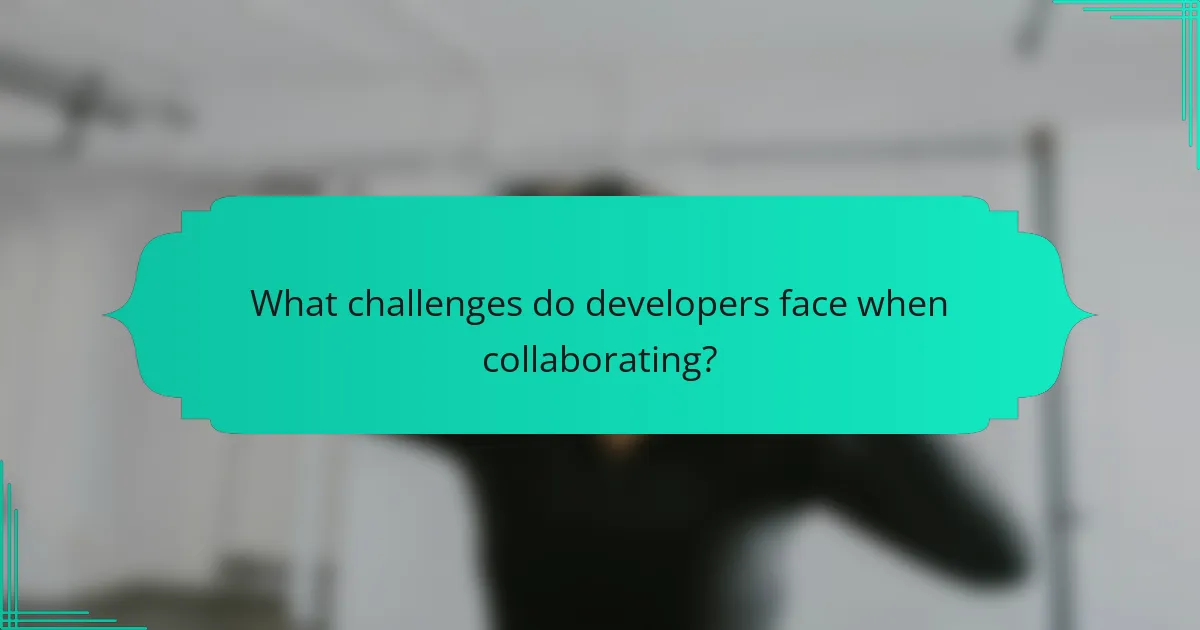
What challenges do developers face when collaborating?
Developers face several challenges when collaborating, including communication barriers, differing coding styles, and version control issues. Effective collaboration requires clear communication to ensure everyone understands project goals and technical requirements. Different coding styles can lead to inconsistencies in the codebase, making it harder to maintain and debug. Version control issues arise when multiple developers work on the same files, potentially causing conflicts and loss of work. Addressing these challenges involves establishing coding standards, utilizing collaboration tools, and maintaining regular updates.
How can communication barriers affect collaboration?
Communication barriers can significantly hinder collaboration by creating misunderstandings and reducing efficiency. These barriers may arise from language differences, cultural misunderstandings, or varying communication styles. As a result, team members may struggle to share ideas effectively, leading to frustration and decreased productivity. Addressing these barriers through clear communication strategies and fostering an inclusive environment can enhance collaboration among developers.
What role does time zone difference play in developer collaboration?
Time zone differences can complicate developer collaboration by creating scheduling challenges. Coordinating meetings and deadlines across various time zones may lead to delays and miscommunication. However, leveraging asynchronous communication tools can mitigate these issues. Establishing clear expectations and flexible working hours can enhance collaboration despite time differences.
Which common conflicts arise in collaborative projects?
Common conflicts in collaborative projects include miscommunication, differing priorities, and unclear roles. These issues can lead to delays and frustration among team members. Effective communication and clearly defined responsibilities can mitigate these challenges. Additionally, establishing a collaborative culture fosters trust and cooperation.
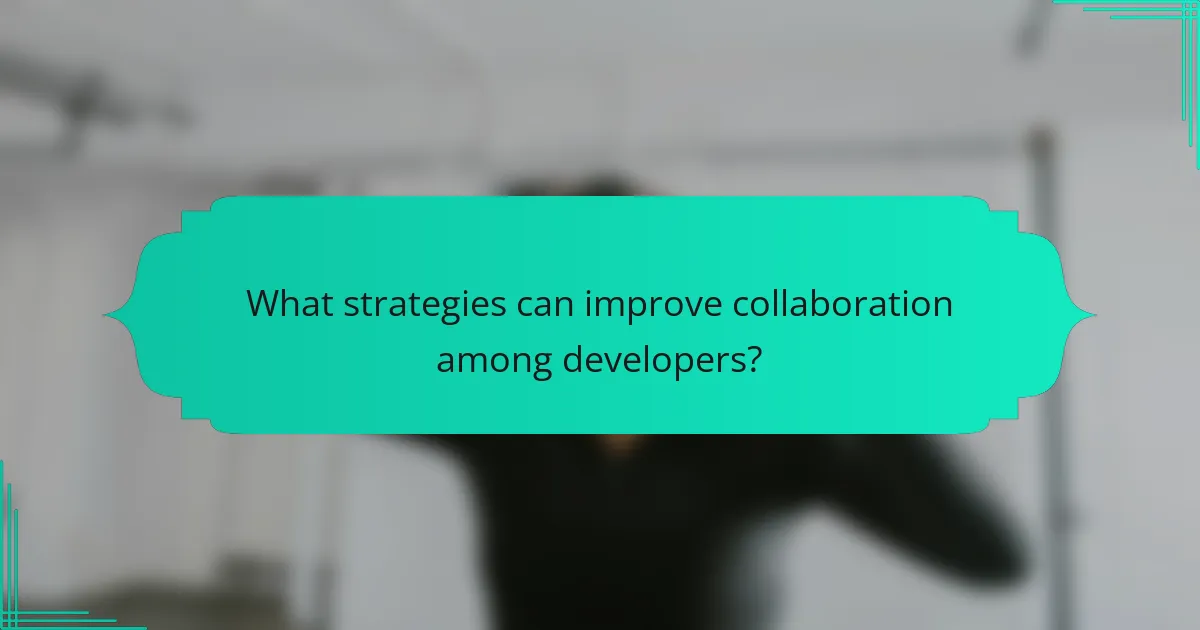
What strategies can improve collaboration among developers?
Improving collaboration among developers requires implementing effective communication, utilizing collaborative tools, fostering a culture of trust, and establishing clear roles. These strategies enhance teamwork and productivity.
Effective communication ensures that all team members are aligned on project goals. Regular meetings and updates can address challenges promptly.
Collaborative tools, such as version control systems and project management software, facilitate real-time collaboration and streamline workflows. These tools help keep everyone informed and engaged.
Fostering a culture of trust encourages open dialogue and feedback. Team members are more likely to share ideas and concerns in a supportive environment.
Establishing clear roles and responsibilities minimizes confusion and enhances accountability. When everyone knows their tasks, collaboration becomes more efficient.
How can project management tools facilitate teamwork?
Project management tools enhance teamwork by streamlining communication, tracking progress, and organizing tasks. These tools foster collaboration through shared platforms, enabling developers to align on project goals and deadlines.
Effective project management tools offer real-time updates, which reduce miscommunication and keep all team members informed. Features like task assignments and deadline reminders ensure accountability and clarity in responsibilities.
Challenges such as tool complexity or resistance to change can arise. Solutions include providing training and fostering a culture that embraces technology.
Ultimately, the right project management tools facilitate smoother workflows and improve overall team efficiency.
What are effective communication practices for remote collaborations?
Effective communication practices for remote collaborations include regular check-ins, clear documentation, and the use of collaborative tools. These practices enhance team cohesion and project clarity.
Establishing a routine for virtual meetings fosters accountability and encourages open dialogue. Tools like Slack or Microsoft Teams facilitate quick communication, while platforms such as Trello or Asana help in tracking project progress.
Additionally, providing comprehensive documentation ensures that all team members have access to essential information, reducing misunderstandings.
Lastly, fostering a culture of feedback promotes continuous improvement and strengthens relationships among team members.
Which methods can be used to establish clear roles and responsibilities?
Establishing clear roles and responsibilities can be achieved through effective communication, documentation, and tool utilization. Define specific tasks for each developer to enhance collaboration and minimize overlap. Regular check-ins and feedback sessions can also clarify expectations and ensure accountability. Using project management tools can streamline role assignments and track progress efficiently.
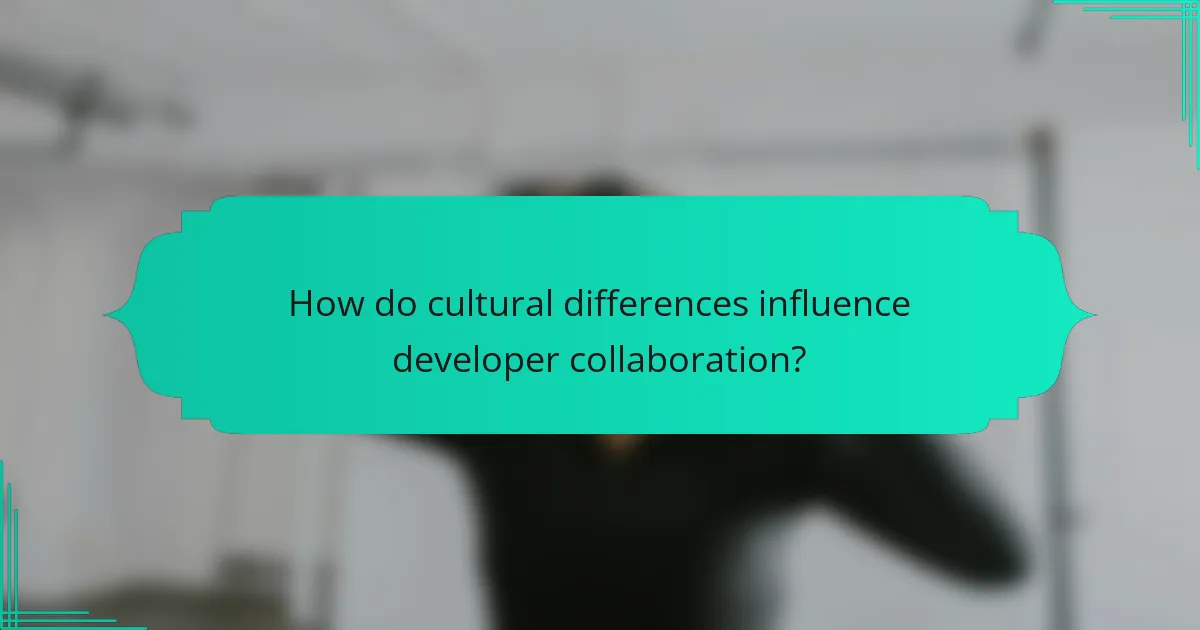
How do cultural differences influence developer collaboration?
Cultural differences significantly impact developer collaboration by influencing communication styles, decision-making processes, and conflict resolution strategies. Understanding these variations can enhance teamwork and project outcomes.
Developers from different cultures may exhibit distinct approaches to collaboration. For instance, some cultures prioritize direct communication, while others favor indirect methods. This can lead to misunderstandings if not addressed. Additionally, cultural attitudes towards hierarchy can affect how decisions are made and who participates in discussions.
To bridge cultural gaps, teams can implement strategies such as establishing clear communication protocols and encouraging open dialogue. Regular team-building activities can foster trust and understanding among members. By acknowledging and respecting cultural differences, developers can create a more cohesive and effective collaborative environment.
What are the benefits of diverse teams in software development?
Diverse teams in software development enhance creativity, problem-solving, and innovation. They bring varied perspectives that lead to better product outcomes. Collaboration among team members with different backgrounds fosters a culture of inclusion and adaptability. Research indicates that diverse teams can improve performance by up to 35%, driving higher levels of engagement and productivity. This diversity also helps in addressing a wider range of user needs, ultimately leading to more successful software solutions.
How can cultural awareness enhance collaborative efforts?
Cultural awareness significantly enhances collaborative efforts by fostering mutual respect and understanding among team members. This awareness leads to improved communication, reducing misunderstandings that can arise from cultural differences. It also encourages diverse perspectives, which can drive innovation and creativity in problem-solving. Furthermore, teams that embrace cultural awareness often experience higher morale and cohesion, resulting in more effective collaboration and project outcomes.
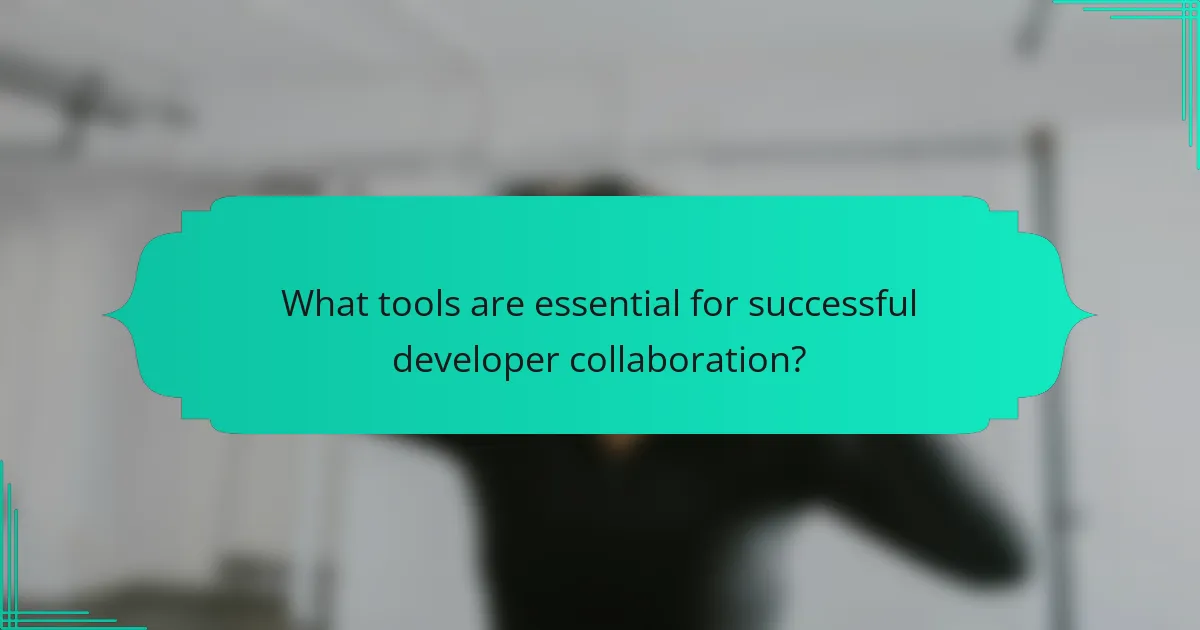
What tools are essential for successful developer collaboration?
Effective developer collaboration requires tools that enhance communication, project management, and code sharing. Essential tools include version control systems, project management software, and communication platforms.
| Tool | Purpose | Example |
|————————–|——————————————-|———————|
| Version Control System | Tracks code changes and collaboration | Git |
| Project Management Software| Organizes tasks and timelines | Jira |
| Communication Platform | Facilitates real-time discussions | Slack |
| Code Review Tools | Enhances code quality through feedback | GitHub Pull Requests |
| Continuous Integration | Automates testing and deployment | Jenkins |
| Documentation Tools | Maintains project knowledge | Confluence |
Which platforms are popular for code sharing and version control?
Popular platforms for code sharing and version control include GitHub, GitLab, Bitbucket, and SourceForge. These platforms facilitate collaboration among developers by providing tools for version control, issue tracking, and code review.
GitHub stands out with its vast community and integration capabilities. GitLab offers built-in CI/CD tools, enhancing the development workflow. Bitbucket integrates seamlessly with Jira, making it ideal for teams using Atlassian products. SourceForge is known for open-source projects, providing a repository for developers to share and collaborate on software.
Each platform has unique attributes, catering to different developer needs and project types.
What features should collaboration tools offer for maximum efficiency?
Collaboration tools should offer features like real-time editing, task management, communication channels, file sharing, and integration with other software. These attributes enhance efficiency by streamlining workflows and improving team coordination. Real-time editing allows multiple developers to work simultaneously, reducing delays. Task management features help prioritize work and track progress. Communication channels foster instant feedback and discussion, while file sharing ensures easy access to resources. Integration with other software creates a seamless experience across tools, enhancing productivity.
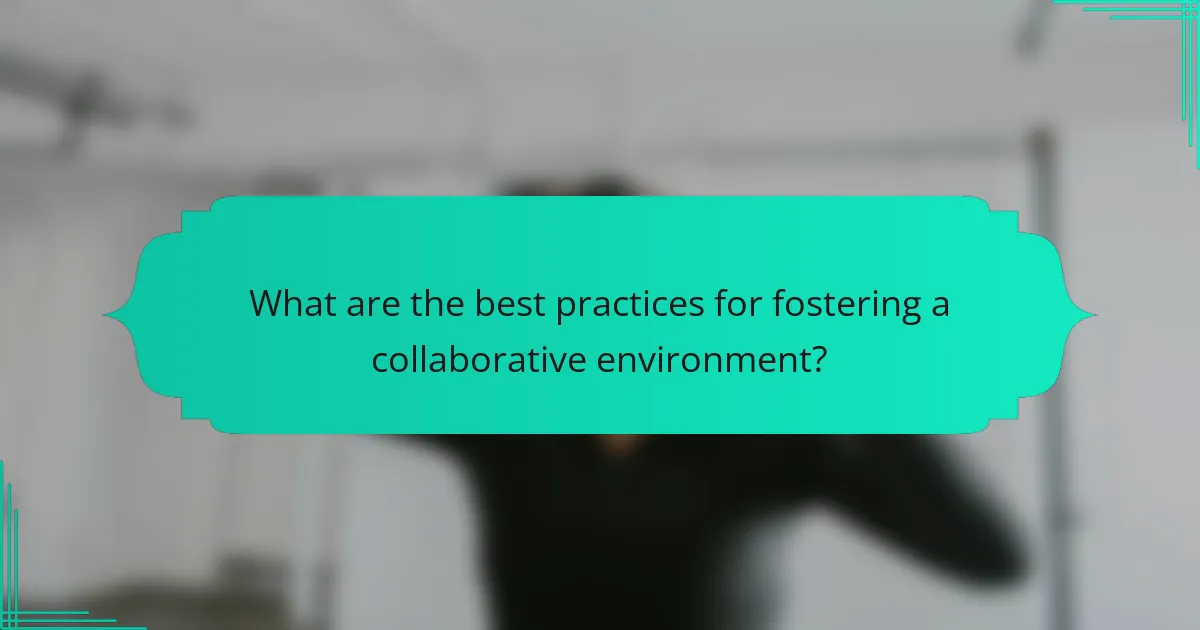
What are the best practices for fostering a collaborative environment?
Fostering a collaborative environment involves clear communication, shared goals, and mutual respect. Establish regular check-ins to enhance team cohesion. Encourage open feedback to address challenges promptly. Provide collaborative tools to streamline processes. Recognize individual contributions to motivate the team.
How can regular feedback loops improve collaboration?
Regular feedback loops enhance collaboration by fostering open communication and continuous improvement. They allow developers to share insights, identify challenges, and adapt quickly to changes. This iterative process builds trust and strengthens team dynamics, ultimately leading to more effective problem-solving and innovation. Regular feedback promotes accountability, ensuring that all team members are aligned and engaged in the development process.
What techniques can be implemented to build trust among team members?
Building trust among team members can be achieved through open communication, consistent feedback, and team-building activities. Open communication fosters transparency and encourages sharing ideas. Consistent feedback helps members understand expectations and improve performance. Team-building activities strengthen relationships and promote collaboration.
What common mistakes should be avoided in collaborative projects?
To avoid common mistakes in collaborative projects, focus on clear communication, defined roles, and setting realistic deadlines. Misunderstandings often arise from vague expectations, leading to conflicts. Ensure all team members understand their responsibilities to foster accountability. Additionally, regular check-ins can help identify issues early, preventing escalation.
How to measure the success of collaborative efforts?
To measure the success of collaborative efforts, assess outcomes against predefined goals. Key metrics include project completion time, quality of deliverables, and team satisfaction. Regular feedback loops enhance communication and identify areas for improvement. Tracking these elements ensures alignment with objectives and fosters continuous growth.
